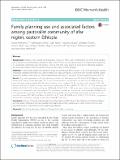| dc.contributor.author | Alemayehu, Mussie | |
| dc.contributor.author | Lemma, Hailemariam | |
| dc.contributor.author | Abrha, Kidan | |
| dc.contributor.author | Adama, Yohannes | |
| dc.contributor.author | Fisseha, Girmatsion | |
| dc.contributor.author | Yebyo, Henock | |
| dc.contributor.author | Gebeye, Ejigu | |
| dc.contributor.author | Negash, Kassahun | |
| dc.contributor.author | Yousuf, Jemal | |
| dc.contributor.author | Fantu, Tigist | |
| dc.contributor.author | Gebregzabher, Tesfay | |
| dc.contributor.author | Medhanyie, Araya Abrha | |
| dc.date.accessioned | 2021-08-23T19:49:56Z | |
| dc.date.available | 2021-08-23T19:49:56Z | |
| dc.date.issued | 2016-01 | |
| dc.identifier.citation | Alemayehu, M., Lemma, H., Abrha, K. et al. Family planning use and associated factors among pastoralist community of afar region, eastern Ethiopia. BMC Women's Health 16, 39 (2016). https://doi.org/10.1186/s12905-016-0321-7 | en_US |
| dc.identifier.issn | 1472-6874 | |
| dc.identifier.uri | http://repository.amref.org/handle/123456789/126 | |
| dc.description | © 2016 The Author(s). Open Access This article is distributed under the terms of the Creative Commons Attribution 4.0
International License (http://creativecommons.org/licenses/by/4.0/), which permits unrestricted use, distribution, and
reproduction in any medium, provided you give appropriate credit to the original author(s) and the source, provide a link to
the Creative Commons license, and indicate if changes were made. The Creative Commons Public Domain Dedication waiver
(http://creativecommons.org/publicdomain/zero/1.0/) applies to the data made available in this article, unless otherwise stated. | en_US |
| dc.description.abstract | Background: Ethiopia is the second most populous country in Africa with a total fertility rate (TFR) of 4.8 children
per a woman and contraceptive prevalence rate (CPR) of 29 %. The overall prevalence of modern family planning
in a pastoralist community, like Afar region, is low (9.1 %). This study aimed to assess family planning utilization
and associated factors among married women of Afar region, Eastern Ethiopia.
Methods: A community-based cross-sectional study was conducted from January 10-28, 2013 among 602 women.
Multistage sampling technique was used to select the study participants. Descriptive and multiple variable logistic
regression analyses were done to isolate independent predictors on utilization of family planning using SPSS 20.
Results: The overall prevalence of family planning utilization in Afar region was 8.5 % (6.2–10.7). Majority of the
women (92.2 %) had used injectable. The most common reasons mentioned in the non-use of family planning
methods were religion-related (85.3 %), desire to have more children (75.3 %), and husband's objection (70.1 %).
Women who had a positive attitude towards family planning utilization (AOR = 4.7, 95 % CI: 2.1, 10.3), owning radio
(AOR = 1.8, 95 % CI: 1.02, 4.18), and literate (AOR = 4.4, 95 % CI: 1.80, 11.08) were more likely to use family planning
methods as compared to their counterparts. The increase of monthly income was also associated with the likelihood
of family planning methods utilization. The odds of using family planning methods were higher among those with
monthly income of $27–$55.5 (AOR = 2. 0, 95 % CI: 1.9, 4.7) and > $55 (AOR = 4. 6, 95 % CI: 1.23–17.19) as compared to
women with the lowest category of monthly income ($27 and less).
Conclusion: The low coverage of family planning in the region could be due to the influence of husband, religious
and clan leader. Attitude of women towards family planning methods, possession of radio, monthly income, and
educational status could influence family planning utilization. | en_US |
| dc.description.sponsorship | AMREF Health Africa | en_US |
| dc.language.iso | en | en_US |
| dc.publisher | BMC Women's Health | en_US |
| dc.subject | Afar | en_US |
| dc.subject | Family planning | en_US |
| dc.subject | Utilization | en_US |
| dc.subject | Ethiopia | en_US |
| dc.subject | Pastoralist community | en_US |
| dc.title | Family Planning Use and Associated Factors Among Pastoralist Community of Afar region, Eastern Ethiopia | en_US |
| dc.type | Article, Journal | en_US |


